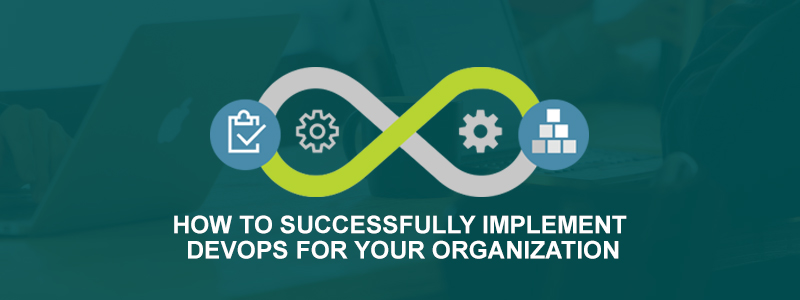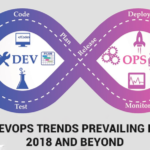DevOps is fast getting adopted across organizations as one of the most popular ways to efficiently accomplish software deliveries and security updates. And this does not anymore remain confined to the client project deliveries but has also been implemented to the internal projects by most of these businesses. The very philosophy of DevOps lies in the speed, reliability and efficiency it imparts to your processes. This is enabled by inculcating a collaborative work environment with speedy and frequent releases and automation coupled with cloud based tool-set. The recent surge in the interest shown by most organizations for DevOps stems mainly from its beneficial aspects including development of high quality bugs-free products, high degree of innovation, one click-deployments and many more.
In short, DevOps lets you add more speed & reliability to your software delivery. Despite being cognizant of all its benefits, many organization still find it challenging to successfully implement this new method to their existing work-flow so as to reap its real benefits. This post is therefore, about some useful tips that can help your organization get a good head-start when it comes to implementing DevOps to your work-flow:
1. Take small steps to start & scale-up later
Considering any organization’s innate resistance to change, it makes perfect sense to begin with taking small steps towards DevOps or implementing it at a rather small scale and later, moving forward with the scaling up process. This can prove to be effective if you are successful at getting positive results while starting on a small scale, whereas if we are to undertake it on a large scale right away, it can take longer & have more chances of failure owing to a variety of factors. So, instead of attempting to automate the processes from end-to-end, you can focus on smaller steps such as continuous integration or simply practicing frequent changes to small batch-size in a project. So, ideally a DevOps project should be started large enough to be able to solve something of significance – to get measurable results and small enough to manage the risks associated with it – for ensuring a successful – scoping the project right is the key here.
2. Experiment. Try. Fail. Learn. Repeat!
It is not just DevOps that serves to bring in agility to your operations but the best practice is to add an element of agility to your DevOps implementation itself. The meaning thereby is that the organizations that are well-adapted to the culture of learning through experimentation and open to accepting and coping with the failures incidental to this process will have an edge over the others for successful implementation of DevOps. This is the reason why smaller organizations and start-ups typically find it easier to successfully adopt DevOps in their work culture as an integral part of it. Since DevOps requires you to calibrate and standardize various aspects such as which all tools may be required, the organization must get into the learning mode at all levels while implementing DevOps. So, it is more like you need to plan about what goal your business wants to achieve and then you start your journey to this goal and learn how to go, along the way! In this case, it helps if the bottlenecks are identified and discussed among the team early on – which may be the reason why you may need to hire the industry experts such as InstaCarma to handhold you.
3. Build flexibility & the accommodation for failure
The organizations need to build the ability to accommodate failures rather than just doing away with the possibilities of failures. With all the experimentation required as a part of rolling out this new technology and with all the trial and error, failures are bound to be encountered. So, if the organization is ready with the mindset to accommodate those failures, it is ready to welcome the DevOps culture with open arms. So, DevOps requires the change management process of your organization to become more scalable, decentralized and compatible with your teams’ understanding as to how to respond as you move ahead.
4. Take your team along as you plan & move ahead
A successful DevOps implementation requires you to take everyone in your organizational hierarchy along as you move ahead. This requires you to study and analyze the motivation level of every individual contributor for working in a cross-team collaborative environments and, how reward & incentivize them to reinforce the desired behaviors in them. Buying in people matters even more in the service industry where it is not just the running of database, infrastructure or the network matters but what matters here is the running of the database that can help the development teams deliver real value. So, the desired outcome of the entire exercise is the continuous delivery of qualitative software.
5. Inculcate the culture of ‘no blame on anyone’
As you embark on your DevOps journey, you must adopt an organizational culture of ‘no blame on anyone’. So, when an issue arises the focus ought to be around ‘what’ went wrong and not on ‘who’ did it wrong. The foundation of DevOps lies in creation of mutually trusting and collaborative environment which is just not possible with a ‘blaming’ and ‘punishing’ mindset. So, focus on positive reinforcement of the desired behavior rather than negative. This will help you achieve a work culture where you can do away with the organizational and information silos. With a more solution-oriented approach, the setbacks can be managed more effectively without the need to put the blame on people.
As an organization setting its initial steps in the world of DevOps, these are some of the basics you can follow. Adoption of DevOps is going to be a ‘learn-as-you-go’ process for your business regardless of its industry type and size. This is the reason why having experienced DevOps professionals to handhold you through the process helps you identify the possible glitches better and ensure that your organization can successfully adopt to this new & effective method of software delivery.
















